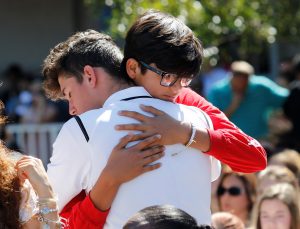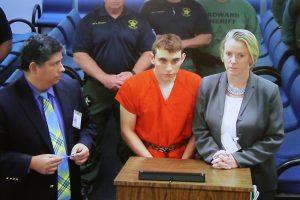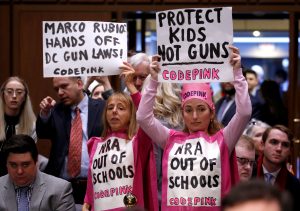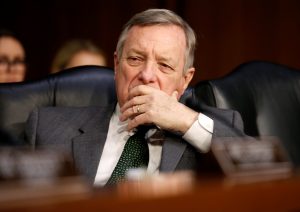
By Bernie Woodall and Zachary Fagenson
PARKLAND, Fla. (Reuters) – The Federal Bureau of Investigation was warned in September about an ominous online comment by the 19-year-old man accused of killing 17 people at his former high school but was unable to locate him, an agent said on Thursday.
Authorities said the ex-student, identified as Nikolas Cruz, walked into the Marjory Stoneman Douglas High School in Parkland, near Miami, on Wednesday and opened fire with an AR-15-style assault rifle in the second-deadliest shooting at a public school in U.S. history.

Students from Marjory Stoneman Douglas High School attend a memorial following a school shooting in Parkland, Florida, U.S., February 15, 2018. REUTERS/Thom Baur
Cruz may have left warning signs on social media in the form of a comment on a YouTube video that read “I’m going to be a professional school shooter.” That comment troubled the person whose video Cruz commented on, Mississippi bail bondsman Ben Bennight, who passed it on to the FBI, according to a video he posted online late Wednesday.
“No other information was included with that comment which would indicate a time, location or the true identity of the person who made the comment,” FBI Special Agent in Charge Robert Lasky told reporters. Investigators were unable to find the commenter, he added.
The FBI is conducting an extensive review of how it handled that tip to see if mistakes were made, a federal law enforcement official told Reuters.
Wednesday’s shooting was the 18th in a U.S. school this year, according to gun control group Everytown for Gun Safety. It stirred the long-simmering U.S. debate on the right to bear arms, which is protected by the Second Amendment of the U.S. Constitution.
President Donald Trump addressed the shooting in a White House speech that emphasized school safety and mental health while avoiding any mention of gun policy.
“It is not enough to simply take actions that make us feel like we are making a difference,” Trump said at the White House. “We must actually make that difference.”
Broward County schools superintendent Robert Runcie called for action on gun laws.
“Now is the time for this country to have a real conversation on sensible gun control laws,” Runcie told a news conference.
Democrats in the U.S. House of Representatives criticized the Republican leadership for refusing to take up legislation on tightening background checks for prospective gun buyers.

Mourners react during a community prayer vigil for victims of yesterday’s shooting at nearby Marjory Stoneman Douglas High School in Parkland, at Parkridge Church in Pompano Beach, Florida, U.S., February 15, 2018. REUTERS/Jonathan Drake
“It’s appalling,” Representative Mike Thompson told reporters. “Thirty people every day are killed by someone using a gun, and the best we can do is say we need more information?”
The Republican-controlled Congress last year revoked Obama-era regulations meant to make it harder for those with severe mental illness to pass FBI background checks for guns, saying the rule deprived the mentally ill of their gun rights.
At least one member of Trump’s cabinet called for action.
“Personally I think the gun violence, it’s a tragedy what we’ve seen yesterday, and I urge Congress to look at these issues,” Treasury Secretary Steven Mnuchin told lawmakers.
Fifteen people were injured in Wednesday’s shooting, according to local hospital officials.
‘BROKEN HUMAN BEING’
Cruz’s court-appointed lawyer said he had expressed remorse for his crimes.
“He’s a broken human being,” public defender Melisa McNeill told reporters. “He’s sad, he’s mournful he’s remorseful.”

Nikolas Cruz (C) appears via video monitor with Melisa McNeill (R), his public defender, at a bond court hearing after being charged with 17 counts of premeditated murder, in Fort Lauderdale, Florida, U.S., February 15, 2018. REUTERS/Susan Stocker/Pool
Cruz had done paramilitary training with a white nationalist militia called the Republic of Florida, a leader of the group said.
“He had some involvement with the Clearwater Republic of Florida cell at some point,” Jordan Jereb said in a telephone interview. Reuters could not immediately verify the claim.
Cruz loved guns and had been expelled from high school for disciplinary reasons, police and former classmates said.
Authorities said he marched into the school wearing a gas mask and tossed smoke grenades, as well as pulling a fire alarm that sent students and staff pouring from classrooms as he began his rampage, according to Florida’s two U.S. senators, who were briefed by federal authorities.
In a brief court appearance, Cruz spoke only two words, “Yes ma’am,” when a judge asked him to confirm his name. He was ordered held without bond.
Cruz had recently moved in with another family after his mother’s death in November, according to Jim Lewis, a lawyer representing the family and local media, bringing his AR-15 along with his other belongings.
The family believed Cruz was depressed, but attributed that to his mother’s death, not mental illness.
Victims included an assistant football coach who sheltered students, a social science teacher and multiple students.
People who live on same street as Cruz said he alarmed them by shooting squirrels and rabbits in the neighborhood as well as chickens being raised in a nearby backyard. Several times a year, they observed law enforcement officials at his house.
“Killing animals was no problem for this young man,” said Rhoda Roxburgh, 45, who lived on the block for several years and whose parents continue to live there.
(Additional reporting by Jonathan Allen and Peter Szekely in New York, David Alexander, Lindsay Dunsmuir, Mark Hosenball and Susan Heavey in Washington, Jon Herskovitz in Austin and Brendan O’Brien in Milwaukee; Writing by Scott Malone; Editing by Jeffrey Benkoe and Tom Brown)








